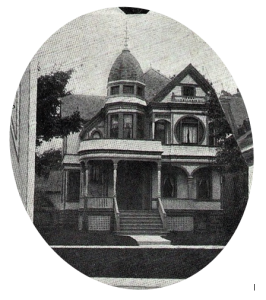Big chunks of Port Huron’s historic environment have been taken through the rise of (1) the central city and county governmental offices and (2) St. Clair County Community College. But McLaren Hospital and its sphere of influence make up a third big chunk. (Of course, much has been lost outside of these chunks as well.)
Recently, a nice Canadian museum volunteer inquired about a house that formerly stood across from Pine Grove Park, and it accelerated my interest in discovering what buildings used to stand in place of today’s McLaren Hospital. If you know Port Huron, you know that the hospital is not the only reason that historic buildings have been razed in that area, but that the medical offices which sprung up behind it have cleared out some of the city’s historic assets, too. So what are the damages? A quick (preliminary) look at the issue shows that the damages are fairly extensive, if such a measure can be named or rated. An in-depth study should be done to help us understand what this part of Port Huron was like in the city’s past.
Which begs many questions: why weren’t any studies done already? why weren’t the destroyed buildings at least recorded in some fashion (with items and/or architectural features salvaged)? Why does this keep happening? Are there methods for mitigating damage to historic buildings and areas, other than creating historic districts? (Why didn’t the hospital pick a less intrusive location to expand in the first place? Why is it “a good” to prolong man’s life, while at the same time destroying man’s accomplishments? Isn’t the latter a big reason why life is worth living in the first place?)
A bit of history. The hospital’s earliest beginnings stem from “Port Huron Hospital and Home,” established in 1879; its first hospital, built in 1882, was located in distant White Park. In 1905 the hospital moved to Richardson Street to expand, near the present hospital. 1918 saw another expansion and the name was simplified to “Port Huron Hospital” the following year. The hospital again expanded in 1937 (construction had begun in 1932), via a new building along Willow Street, and the 1905 structure was razed. The hospital has gone through numerous expansions, with changes in ownership, ever since (the hospital’s history page does not provide the year that it became owned by the mid-Michigan based McLaren group, but the first reference to it is 2012). It’s current address is 1221 Pine Grove Avenue.

The CE Bricker house. From page 59 of Wm. Black’s “Port Huron in 1900” (on file at the Port Huron Museum).
Do you know what gave its 1221 Pine Grove Avenue address up to the hospital? You can see the Victorian home in the figure at right. It was the home of Chester and Barbara (Livingston) Bricker, as least for a few years, as Barbara died three years after their 1896 marriage. It was probably built by Barbara’s father, James Livingston of linseed oil and Castle Kilbride fame, of Ontario, Canada. Chester Bricker was a druggist and had his own drugstore in Port Huron.
Below is a relatively current aerial view from Google maps. The hospital and medical offices around it (primarily behind it, west to 10th Street) have taken over about 18 city blocks. Virtually all residential and commercial structures that had been in those blocks have been destroyed. Further below are two aspects of an 1894 bird’s eye view map, one showing the same area as the Google map, and another showing a more detailed view of the houses across from Pine Grove Park.

McLaren Hospital and medical offices to the west, Port Huron, Michigan. Google maps, 2016.

1894 Pauli map of Port Huron, detail showing Mclaren Hospital (area at right) and medical offices (are to left) areas outlined in yellow. View is to northwest. (Library of Congress holding.)

1894 Port Huron Pauli map detail showing homes and structures across from Pine Grove Park, now the site of McLaren Hospital.
Here is a photo of some of these houses along Pine Grove Avenue just prior to their demolition (on file at the Port Huron Museum).
As might be expected, perusing the addresses (1100s to 1400s) in the 1904 directory (as a sample) for Pine Grove Avenue yields well-known businessmen, bankers, and board members living in these homes, while moving westward shows the residents to be skilled workers, working professionals, and business owners. Looking at the detail map above, a large house at the corner of Erie and Kearney can be seen, and this might have been the home of Eugene (and Emma) Schoolcraft (of 1131 Erie), a city assessor, President of the GB Stock Xylite Grease & Oil Company, secretary of the Michigan Developing Company (Schoolcraft & Co.), and later, President of the Chamber of Commerce.
Regarding the questions posed above, a future article and resources will be posted. In the meantime, possibilities include Neighborhood Conservation Districts, local historic sites designations, Historic Preservation Overlay Zones, etc. Methods can be found for helping to preserve our neighborhoods, or at least the history behind them.


It was a sad day when those houses were destroyed! That whole area should be under preservation if possible around the lighthouse. Soon those houses from the 1800’s will be all gone!
LikeLiked by 1 person
I agree. Those homes should of never been demolished for a parking structure for the hospital! So sad!!!
LikeLike